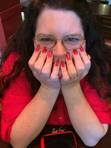A Branding Primer
This great post was pulled from the archives so y'all can brush up on branding! Our guest Laurie Tomlinson is providing a new giveaway today and working on a brand new post to share with us next month.

Thank you so much, Seekers, for inviting this self-professed marketing geek to talk about one of my favorite subjects. Let’s get to it, shall we?
What is Branding and Why Is It Important?
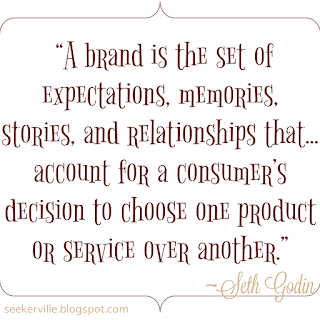 I love marketing guru Seth Godin’s definition:
I love marketing guru Seth Godin’s definition:
“A brand is the set of expectations, memories, stories, and relationships that, taken together, account for a consumer’s decision to choose one product or service over another.”
Many people mistake a cohesive style for brand, and while it’s an important component, it’s only a small part of it.
Branding is the collective story you tell industry professionals and readers about you and your work. It’s what sets you apart from other authors, not in a dog-eat-dog kind of way, but in a way that represents the unique aspects that make you *you*. It’s how, when readers are scrolling through their social media, they can tell a post is from you even before they see your name.
Identifying the Vision and Mission of Your Brand
While an author tagline is great because it tells the audience what they can expect up front, knowing the vision and mission behind your work is most crucial. Everything we write, from the pages of our books, to our query letters, to the tone and content of our social media should tell that for us.
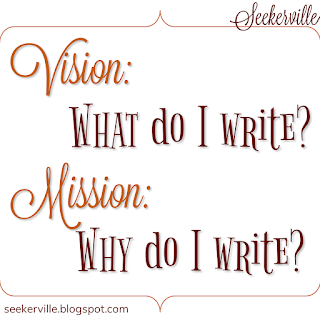 Vision answers the question: What do I write?
Vision answers the question: What do I write?
Mission answers the question: Why do I write?
So if, for example, you write authentic women’s fiction (what) to give readers hope through relatable characters (why), your blog posts will be hope-filled, your voice authentic, and your content primarily centered around women.
Many of us who are doing our heart’s work have huge heart-dreams and run into a snag when trying to be succinct in the themes/topics we cover, but inconsistency will only confuse readers and detract from our message. To create a more defined brand vision and mission, we should go with our strongest values and the characteristics we can see being most cohesive across our unique body of work.
Identifying Our Audience
A huge key to brand is identifying our audience. This is the person who will benefit the most from our work. One thing I’ve always encouraged clients to do is to name the person they’re writing for. Mine is Meg. It may sound kind of weird—especially if you talk about this pretend person in a pitch appointment (cough, or so I’ve been told)—but we all create and talk to imaginary people, so let’s go with it.
Just as we research and profile characters before beginning a new project, it’s important to know and identify as much as possible about our ideal audience. Of course, our work will naturally appeal to a broader range of people, but if we write for anyone and everyone who will listen, our message as a whole will be watered down, and our potential for impact will suffer.
At the very least, identifying age, gender, and what makes this person click a link or pick up a book can be helpful. If you write for more than one genre, then look for the common denominators in your audience and refine from there.
But most importantly, research what your audience needs the most from you. Is it hope? Entertainment? Solidarity? Authenticity? Hopefully, this lines up with the why of your vision and what you uniquely have to offer.

Once you've determined your ideal audience, every branding decision should consider that person. I know it sounds like a lot of work, but you will soon develop an instinct for what (and where) you write, the tones you use, and the messages you send. And your intentionality with your brand will result in the reward of a more meaningful conversation between you and your audience.
A Case Study: In my debut novel,
With No Reservations
In my debut novel,
With No Reservations
 , my heroine Sloane is a popular food blogger who knows a lot about branding and reaching her ideal audience. Her website is called Mise en Place, a French culinary term for assembling ingredients prior to cooking. The photos she uses have distinctive color contrast and always feature shots of the recipe ingredients neatly (and appetizingly!) arranged.
, my heroine Sloane is a popular food blogger who knows a lot about branding and reaching her ideal audience. Her website is called Mise en Place, a French culinary term for assembling ingredients prior to cooking. The photos she uses have distinctive color contrast and always feature shots of the recipe ingredients neatly (and appetizingly!) arranged.
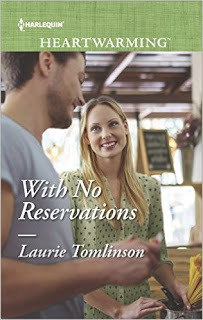 All of her design decisions and word choices reflect an approachable, organized, and beautiful cooking experience because that’s what her audience needs for recipe inspiration.
All of her design decisions and word choices reflect an approachable, organized, and beautiful cooking experience because that’s what her audience needs for recipe inspiration.
Sloane writes to give accessible, step-by-step recipes to home cooks who want to mix up their rotation. Her ideal reader, a busy 30-year-old housewife named Michelle who found her on Pinterest, is attracted to a recipe post because of its beautiful pictures, knows it’s from Sloane because of her unique style of photos, and comes back to the website because the step-by-step format of the recipes makes her feel like she can try anything.
While Sloane’s recipe posts naturally attract a broader audience—men who love to cook, 20-year-olds who are getting their first apartments, and other cooking enthusiasts—the style and content decisions she makes stay true to her vision and what’s accessible and appealing to Michelle. Sloane regularly gauges this, and may shift and adapt things according to the conversation and reader feedback her content generates.
So, to sum things up, it's simple. Once you’ve refined the vision and message for your author brand, the more you will know about your ideal audience. And the more you know about your person, the easier your decisions will be and the more your content will resonate.
What and who are you writing for? Is there an author you can think of with a distinctive brand?
 Two childhood sweethearts. One failed summer romance. Twelve years later.
Two childhood sweethearts. One failed summer romance. Twelve years later.
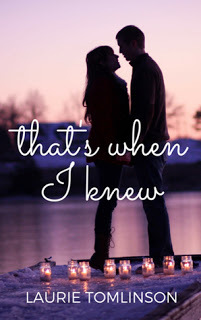 On most days, Chelsea Scott feels like her rapidly growing planner and stationery business should belong to someone else. Maybe if it did, it wouldn't be hovering near the red due to one costly decision. But the collaboration that will save her company awaits her pitch at the trade show she's keynoting. When her transportation falls through at the last minute, she accepts help from Nick Pearson, who’s unexpectedly come back into her life.
On most days, Chelsea Scott feels like her rapidly growing planner and stationery business should belong to someone else. Maybe if it did, it wouldn't be hovering near the red due to one costly decision. But the collaboration that will save her company awaits her pitch at the trade show she's keynoting. When her transportation falls through at the last minute, she accepts help from Nick Pearson, who’s unexpectedly come back into her life.
The last time Nick saw Chelsea, he told her he loved her, and she ran. Twelve years later, their lives are different, more complex than the summers they spent playing baseball and eating ice cream cones at their dock with their toes in the lake. But as they spend time together on the road, their feelings for each other become clear: all those years couldn’t take away how good they can be together.
When Chelsea's past decisions resurface at the convention, her newly rekindled relationship with Nick – and her business – are in jeopardy. Will their love be enough to keep them together or will another summer end with them apart?
Goodreads | Amazon
Leave a comment today for an opportunity to win
an ebook copy of That's When I Knew. OR pick up your own copy at just $0.99 for a limited timeWinner announced in the Weekend Edition.
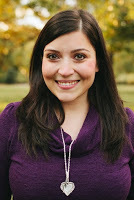 Laurie Tomlinson is a wife and mom from Tulsa, Oklahoma, who enjoys stories of grace in the beautiful mess. She is a member of the American Christian Fiction Writers and regular contributor to The Writers Alley Blog. Her work is represented by Rachel Kent of Books & Such Literary, has won two Genesis Awards, and was runner-up in the 2015 RWA Lone Star Contest.
Laurie Tomlinson is a wife and mom from Tulsa, Oklahoma, who enjoys stories of grace in the beautiful mess. She is a member of the American Christian Fiction Writers and regular contributor to The Writers Alley Blog. Her work is represented by Rachel Kent of Books & Such Literary, has won two Genesis Awards, and was runner-up in the 2015 RWA Lone Star Contest.
Website | Facebook | Twitter | Instagram

Thank you so much, Seekers, for inviting this self-professed marketing geek to talk about one of my favorite subjects. Let’s get to it, shall we?
What is Branding and Why Is It Important?
 I love marketing guru Seth Godin’s definition:
I love marketing guru Seth Godin’s definition:“A brand is the set of expectations, memories, stories, and relationships that, taken together, account for a consumer’s decision to choose one product or service over another.”
Many people mistake a cohesive style for brand, and while it’s an important component, it’s only a small part of it.
Branding is the collective story you tell industry professionals and readers about you and your work. It’s what sets you apart from other authors, not in a dog-eat-dog kind of way, but in a way that represents the unique aspects that make you *you*. It’s how, when readers are scrolling through their social media, they can tell a post is from you even before they see your name.
Identifying the Vision and Mission of Your Brand
While an author tagline is great because it tells the audience what they can expect up front, knowing the vision and mission behind your work is most crucial. Everything we write, from the pages of our books, to our query letters, to the tone and content of our social media should tell that for us.
 Vision answers the question: What do I write?
Vision answers the question: What do I write?Mission answers the question: Why do I write?
So if, for example, you write authentic women’s fiction (what) to give readers hope through relatable characters (why), your blog posts will be hope-filled, your voice authentic, and your content primarily centered around women.
Many of us who are doing our heart’s work have huge heart-dreams and run into a snag when trying to be succinct in the themes/topics we cover, but inconsistency will only confuse readers and detract from our message. To create a more defined brand vision and mission, we should go with our strongest values and the characteristics we can see being most cohesive across our unique body of work.
Identifying Our Audience
A huge key to brand is identifying our audience. This is the person who will benefit the most from our work. One thing I’ve always encouraged clients to do is to name the person they’re writing for. Mine is Meg. It may sound kind of weird—especially if you talk about this pretend person in a pitch appointment (cough, or so I’ve been told)—but we all create and talk to imaginary people, so let’s go with it.
Just as we research and profile characters before beginning a new project, it’s important to know and identify as much as possible about our ideal audience. Of course, our work will naturally appeal to a broader range of people, but if we write for anyone and everyone who will listen, our message as a whole will be watered down, and our potential for impact will suffer.
At the very least, identifying age, gender, and what makes this person click a link or pick up a book can be helpful. If you write for more than one genre, then look for the common denominators in your audience and refine from there.
But most importantly, research what your audience needs the most from you. Is it hope? Entertainment? Solidarity? Authenticity? Hopefully, this lines up with the why of your vision and what you uniquely have to offer.

Once you've determined your ideal audience, every branding decision should consider that person. I know it sounds like a lot of work, but you will soon develop an instinct for what (and where) you write, the tones you use, and the messages you send. And your intentionality with your brand will result in the reward of a more meaningful conversation between you and your audience.
A Case Study:
 In my debut novel,
With No Reservations
In my debut novel,
With No Reservations
 , my heroine Sloane is a popular food blogger who knows a lot about branding and reaching her ideal audience. Her website is called Mise en Place, a French culinary term for assembling ingredients prior to cooking. The photos she uses have distinctive color contrast and always feature shots of the recipe ingredients neatly (and appetizingly!) arranged.
, my heroine Sloane is a popular food blogger who knows a lot about branding and reaching her ideal audience. Her website is called Mise en Place, a French culinary term for assembling ingredients prior to cooking. The photos she uses have distinctive color contrast and always feature shots of the recipe ingredients neatly (and appetizingly!) arranged. All of her design decisions and word choices reflect an approachable, organized, and beautiful cooking experience because that’s what her audience needs for recipe inspiration.
All of her design decisions and word choices reflect an approachable, organized, and beautiful cooking experience because that’s what her audience needs for recipe inspiration.Sloane writes to give accessible, step-by-step recipes to home cooks who want to mix up their rotation. Her ideal reader, a busy 30-year-old housewife named Michelle who found her on Pinterest, is attracted to a recipe post because of its beautiful pictures, knows it’s from Sloane because of her unique style of photos, and comes back to the website because the step-by-step format of the recipes makes her feel like she can try anything.
While Sloane’s recipe posts naturally attract a broader audience—men who love to cook, 20-year-olds who are getting their first apartments, and other cooking enthusiasts—the style and content decisions she makes stay true to her vision and what’s accessible and appealing to Michelle. Sloane regularly gauges this, and may shift and adapt things according to the conversation and reader feedback her content generates.
So, to sum things up, it's simple. Once you’ve refined the vision and message for your author brand, the more you will know about your ideal audience. And the more you know about your person, the easier your decisions will be and the more your content will resonate.
What and who are you writing for? Is there an author you can think of with a distinctive brand?
 Two childhood sweethearts. One failed summer romance. Twelve years later.
Two childhood sweethearts. One failed summer romance. Twelve years later. On most days, Chelsea Scott feels like her rapidly growing planner and stationery business should belong to someone else. Maybe if it did, it wouldn't be hovering near the red due to one costly decision. But the collaboration that will save her company awaits her pitch at the trade show she's keynoting. When her transportation falls through at the last minute, she accepts help from Nick Pearson, who’s unexpectedly come back into her life.
On most days, Chelsea Scott feels like her rapidly growing planner and stationery business should belong to someone else. Maybe if it did, it wouldn't be hovering near the red due to one costly decision. But the collaboration that will save her company awaits her pitch at the trade show she's keynoting. When her transportation falls through at the last minute, she accepts help from Nick Pearson, who’s unexpectedly come back into her life.The last time Nick saw Chelsea, he told her he loved her, and she ran. Twelve years later, their lives are different, more complex than the summers they spent playing baseball and eating ice cream cones at their dock with their toes in the lake. But as they spend time together on the road, their feelings for each other become clear: all those years couldn’t take away how good they can be together.
When Chelsea's past decisions resurface at the convention, her newly rekindled relationship with Nick – and her business – are in jeopardy. Will their love be enough to keep them together or will another summer end with them apart?
Goodreads | Amazon
Leave a comment today for an opportunity to win
an ebook copy of That's When I Knew. OR pick up your own copy at just $0.99 for a limited timeWinner announced in the Weekend Edition.
 Laurie Tomlinson is a wife and mom from Tulsa, Oklahoma, who enjoys stories of grace in the beautiful mess. She is a member of the American Christian Fiction Writers and regular contributor to The Writers Alley Blog. Her work is represented by Rachel Kent of Books & Such Literary, has won two Genesis Awards, and was runner-up in the 2015 RWA Lone Star Contest.
Laurie Tomlinson is a wife and mom from Tulsa, Oklahoma, who enjoys stories of grace in the beautiful mess. She is a member of the American Christian Fiction Writers and regular contributor to The Writers Alley Blog. Her work is represented by Rachel Kent of Books & Such Literary, has won two Genesis Awards, and was runner-up in the 2015 RWA Lone Star Contest.Website | Facebook | Twitter | Instagram
Published on October 16, 2018 21:00
No comments have been added yet.

